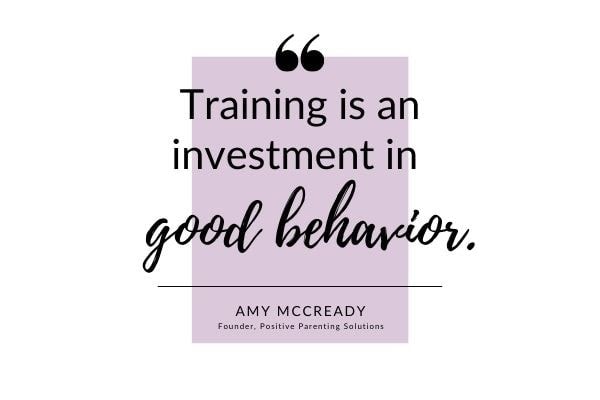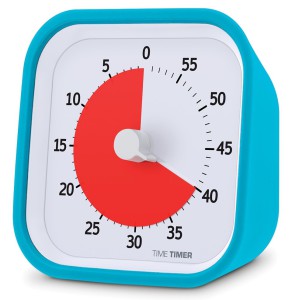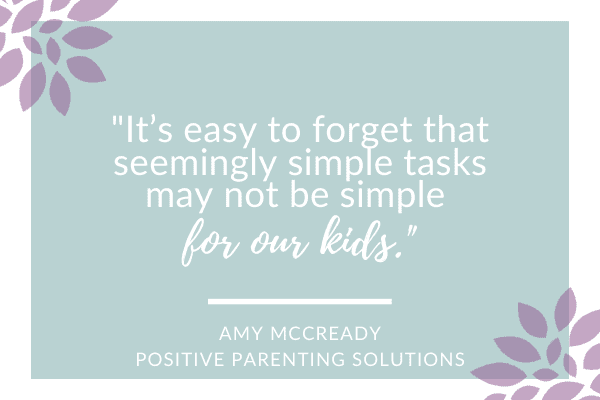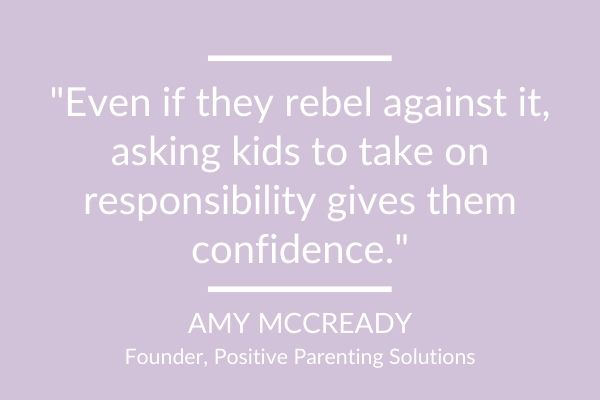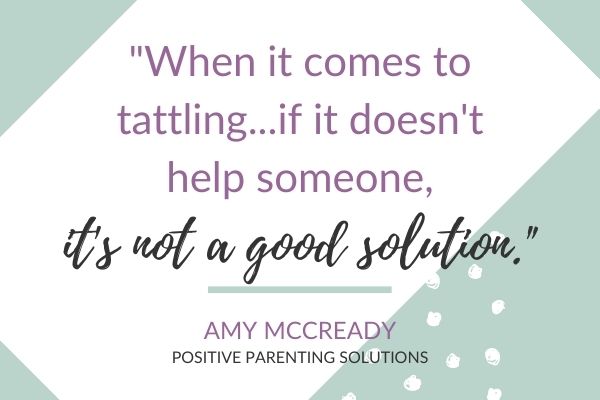


You’ve kindly asked, begged, and bribed–but he just won’t budge.
It’s time for the final countdown.
“Justin, you have three seconds to put that toy back on the shelf.”
Your 5-year-old remains motionless–despite your warning.
“1…2…”
Still nothing.
“2 ½, 2 ¾…”
As you raise your voice, the eyebrows of fellow bystanders raise, too. This is becoming a public battle of wills.
You definitely don’t want to cause a scene, but you also need immediate cooperation.
“Justin, I told you we weren’t going to buy a toy at the supermarket. If I reach the count of 3, you’re going to be in BIG trouble!!……..”
……….
“3!“
Maybe, after your final warning, Justin will budge.
But, maybe–and just as likely–he won’t. You might even have to chase him down the crowded aisle and pry the toy from his tiny, yet iron-like, fingertips.
In either case, counting for compliance is not an ideal tactic.
Though many of us regularly rely on this strategy, there are a few reasons why it isn’t going to help our kids–or us–in the long run. (To discover more effective disciplinary measures, sign up right now for our FREE CLASS: Get Kids to Listen Without Nagging, Yelling, or Losing Control!)
Want the scoop on this age-old tactic?
Here are 4 reasons why counting “1-2-3” doesn’t stop bad habits–it prolongs them.
1. We’re Allowing Kids to Ignore Us
Think about it: counting to three teaches kids they really don’t have to listen the first time. Instead, they learn they have several opportunities before they have to respond to us.
Even though our blood increasingly boils each moment of a countdown, our kids’ minds read something like this:
“Okay, I’m good here for a while. I’m going to keep doing what I’m doing.”
“He just started counting. I don’t have to do anything quite yet. I’ve got time.”
By counting “1-2-3,” we’re actually giving our children 3 or more chances to ignore us. We probably asked them once or twice before we started counting. Add a “two and a half” and a “two and three-quarters,” and we’re up to 6-7 opportunities to be tuned out.
Effectively, our kids have learned to ignore us–and wouldn’t we rather them listen the first time we make a request?
Plus, teaching our kids to listen the first time and be more cooperative helps them outside the home, too. After all, a student can’t delay submitting his book report until the teacher has requested it several times. Not if he wants to get a good grade, anyway.
Nor will a coach play a student in the next big game who repeatedly fails to listen to team strategy and instructions.
Our children won’t always get multiple opportunities outside the home, so it’s important that we set the expectation for listening the first time while they’re in our care.
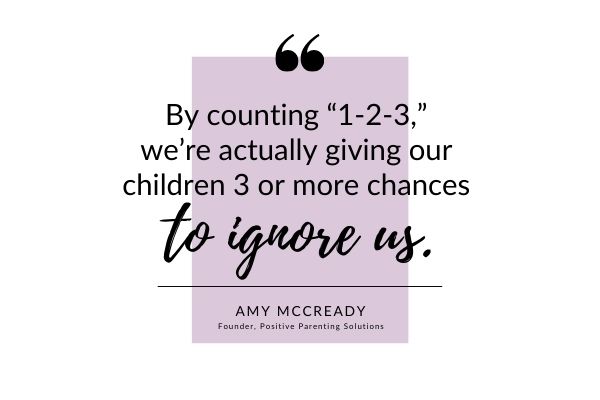
2. Our Kids’ Responsibility Becomes Ours–and Entitlement Grows
When we feel the need to count, who isn’t listening and helping? Our kids. But who is getting angry, frustrated, and doing the work? Us.
When children don’t cooperate, parents often (mistakenly) deploy discipline strategies–punishment, time-out, countdowns, etc.– that turn those misbehaviors into the parent’s problem.
In short, it becomes incumbent on the parent to force the child to comply instead of placing the onus on the misbehaving child.
This, my friends, is WAY too accommodating.
Occasional leniency may be relatively harmless, but a lot of it can lead to entitlement.
Breeding entitlement is surprisingly easy, because it usually doesn’t come from a parent’s conscious effort to reward their kids or spoil them beyond measure.
Instead, it sneakily arises from small, everyday actions that give kids more leeway, advantages, and excuses to shirk responsibility.
Counting to 3 is one small action that does this by transferring responsibility from the kids to the parents. And, over time, when kids push the limits on the countdown, they will get away with more and more–increasing their feelings of entitlement.
3. “1-2-3” Means We’re Willing to Wait…and Negotiate
No means no, right?
But when a lot of parents say “no,” this isn’t the case.
In the scene above, 5-year-old Justin knew he couldn’t have the toy. His dad said, “I told you we weren’t going to buy a toy at the supermarket.”
Telling our children “no” is good–and necessary! It’s important in situations like these to teach our kids they can’t have everything they want.
But, saying “no”–and subsequently counting down until they finally give in–leaves room for children to re-interpret the situation.
“He said ‘no,’ but now he’s counting–so I guess I still have time to play with this toy. Maybe he’ll even change his mind and let me keep it.”
Even though parents see a narrowing window as they count, kids see increasing negotiation power. Depending on how often we rely on counting “1-2-3”, kids may even start to doubt our words and when they need to take us seriously.
4. Counting Sets the Stage for a Power Struggle
Whether our dear 5-year-old, Justin, tightened his grip and ran down the supermarket aisle, threw himself on the floor in a writhing tantrum, or finally–begrudgingly–put back the toy, this was a classic showdown between parent and child.
Children have an innate need for power and control and if those needs aren’t met in legitimate, positive ways, they’ll seek those needs through other means. For the power-seeking child, when given an inch, he’ll take it–and a mile more.
Cue the power struggle.
Power struggles can be common, epic, and ugly. But they don’t have to be.
If Justin still chooses not to listen to his dad–even after he reaches the dreaded count of “3”–what will he do next? He might say, “I’m serious now!” but he probably won’t believe him.
Or, what happens when dad continues to lose control–both literally and figuratively? He might feel the need to yell, spank, or apply other totally ineffective consequences in an attempt to re-instill his authority. Justin, in turn, would further roll up his sleeves for the fight.
4 Tactics to Try Instead of Counting
Luckily, you don’t have to go down this road! Nor do you need to negotiate, accommodate, or be ignored.
Are you ready to take heart and switch gears?
Here are 4 alternate ways to encourage–and earn–your kids’ compliance:
1. Prevention Through Power
Naturally, life would be a lot easier without all these standoffs in stores, at playgrounds, and at bedtime, right?
We all want our kiddos to behave appropriately–without having to employ discipline tactics–but that doesn’t happen without some proactive planning on our part.
The best way to encourage positive behavior is to look at the misbehavior itself. Yes, your child is interested in the toy at the store, but he’s also gaining a HUGE power boost at your expense as you jump through hoops and embarrass yourself to get his cooperation.
So he might want the toy; but even deeper than that, he wants to fill his need for personal power and prove who’s boss.
In fact, Adlerian Psychology–which is what all the tools in the 7-Step Parenting Success System® course are based on–tells us that once physical needs are met, all people have an innate need for attention and emotional connection and a sense of autonomy and personal power.
In kids, when these needs aren’t met positively and proactively, this shows up through misbehaviors like tantrums, whining, arguing, backtalk, and all the rest. They don’t want to misbehave but they don’t have the awareness or the skills to communicate which needs aren’t being met.
But, if we help our kids get that powerful feeling before their power bucket is running low, they will no longer feel the need to lash out, argue, talk back, and more.
It sounds incredible…and it truly is!
So, if that’s you in the grocery store with a 5-year-old, instead of waiting for your child to act out, you’re going to help him feel super empowered.
Give him the list and a pencil so he can check off the items. Let him decide the yogurt flavor. Ask him if he can find the Cheerios box in the cereal aisle. Weigh some vegetables.
Through these small tasks, your son will feel such a strong sense of power that he’ll be more likely to take your “no” for an answer and put the toy back without complaint when asked.
This works wherever you are: during your routines, in the car, as you’re getting ready to leave the park, or any other tricky times of the day. Preplan some empowering activities, and you’ll be much less likely to even need other strategies.
But if you do…
2. Start by Maintaining a Calm Voice
As much as we need to be firm when we make requests of our children, we need to be equally respectful and calm.
Maintaining a Calm Voice, a tool we use in our positive parenting online course, is more powerful than it sounds. Because, in a way, it compels kids to listen without using force.
When your 3-year-old refuses to get in her car seat after several requests, simply replace the urge to count by getting down on her level (physically), making eye contact, and stating the desired behavior in your calm but firm voice.
“Becca, we need to pick your sister up from school now, so I need your help getting in the car seat. You can do so many things by yourself now! Show me how you buckle yourself in!
If your toddler has been loud or screaming, she’ll have to quiet down to hear your voice. Plus, without you yelling, she won’t have to raise her voice to respond. Using a calm voice has immediately blockaded a power struggle because you aren’t angry, upset, or emotional.
Becca is also pleased she can buckle herself in! This added dose of encouragement and self-positivity has further helped her comply.
But if she doesn’t, and continues to ramp up her reaction, you’ll feel much more prepared if you…
3. Train Your Child to Manage Big Emotions
As we follow through with whatever it is we need our child to do–leave the playground, give a snatched toy back to a little sibling, or stop jumping on the couch–children are likely to pitch a fit…especially at first.
As long as no one is in danger, that’s fine. There’s no need to lecture or get angry; empathize that you know he’s disappointed or that it’s hard to share, but move on. The tantrum will pass and your child will learn the valuable lesson that when you say something, you mean it.
In a public place, naturally, this isn’t so easy. And, of course, you’d rather the situation not repeat itself.
The thing is, counting “1-2-3″ doesn’t help our kids get a grip on their defiance, anger, and willpower–it intensifies it!
Instead, training children to manage their feelings and express them appropriately–even in the heat of the moment–is a great alternate solution.
When a child is at his wit’s end and refusing to listen, take a moment to first find out why.
Maybe you purchased Justin a toy the last time you were at the store and he assumes he can have another one. Or maybe he just struggles to hear the word “no.” You can start by asking him why he is upset or encouraging him to describe how he feels.
Also, for kids too young to express their feelings, we can help by labeling their feelings for them.
“Anthony, I know you’re frustrated and angry that your brother gets to listen to Hamilton on the car ride today. It’s hard not to always get what we want.”
After a moment or two, we can add: “But that doesn’t mean you can yell and make noise during his songs. I know you wouldn’t want him to scream over your Disney tunes. Can you imagine how frustrating that would be, too?”
Labeling our kids’ feelings and showing empathy, despite how frustrating their behavior may be, helps them learn to express their emotions in a less dramatic way.
And this helps curb their misbehaviors.
Even a teenager struggling to cooperate can benefit from this tactic. Maybe you’re inclined to give your tween daughter a 5-second countdown after you’ve asked her four times to put her phone away. Instead, you can say:
“Alysha, I know it’s hard to put down the phone. It’s important for you to connect with your friends–and I respect that. But now, it’s time to do your homework.”
Often, this is the only step you’ll need to take. But if your kids are still putting up a stink, your best bet is to ignore the fuss and avoid getting drawn into the power struggle. Leave the room if you need to, but act completely disinterested. They’ll soon get the point.
And what about that dreaded scenario when your preschooler is losing it in public? Usher kids to a location that can withstand a tantrum (outside, the car, or maybe an out-of-the-way corner) and let it run its course. We can show empathy during this process by holding them and acknowledging their disappointment.
Empathy doesn’t mean we’re giving into their demands–it just helps them feel understood.
When they see we’re not budging, kids will, eventually, lose interest. They’ll get the message that pitching a fit doesn’t get them what they want. What’s more, they’re less likely to lose control next time.
4. Take Action with Redirection
Sometimes, parents resort to punishment when counting goes ignored–spanking, time-outs, etc. Other times, counting is an idle threat with no follow-through.
But occasionally, both scenarios can be avoided when we take immediate action and redirect our kids.
Poor Justin may be approaching his wits’ end over this silly toy, but if you quickly whisk him away to see the crabs and lobsters in the seafood aisle BEFORE he erupts, he may just forget it. Or, if you ask him to pick out his favorite brownie mix to make over the weekend, he could be happily distracted.
If you and your 11-year-old are nearing a high-noon showdown over his wanting to stay up past 10, try talking about some of his favorite subjects while tucking him into bed or asking what he’d like to do with you tomorrow after getting a good night’s sleep.
It seems simple, and it is. But taking our kids’ minds off the idea that they’re struggling against us and distracting them in healthy ways is an amazing way to get their cooperation.
The key is to do it before the tension mounts. Once you’re in the middle of a battle, they’re less likely to take your bait and switch gears.
Kids still need to learn to cooperate without distraction, so this tactic may seem like the avoidance of a hard, but important, lesson. In reality, our kids will have plenty of opportunities to hear “no” and other words of opposition.
Picking and choosing our battles and avoiding constant stand-offs will eliminate tension. It will also make conversations about what behavior you expect from them smoother and better received next time.
Final Thoughts
We all want our children to listen the first time we ask, and while counting to 3 might be working for you right now, it’s not the best long-term solution for helping your child become more cooperative and compliant.
So whether you’re counting to 3 out of desperation or conscious choice, I’d love to encourage you to try the strategies above next time you find yourself in a battle of wills.
Or, better yet, you can join me for my FREE CLASS: Get Kids to Listen Without Nagging, Yelling, or Losing Control where I’ll share another favorite tool from my parenting toolbox–the 5Rs to fair and effective consequences.
But for now, which tactic (or three, or four) will you try next time, in place of counting “1-2-3?”




